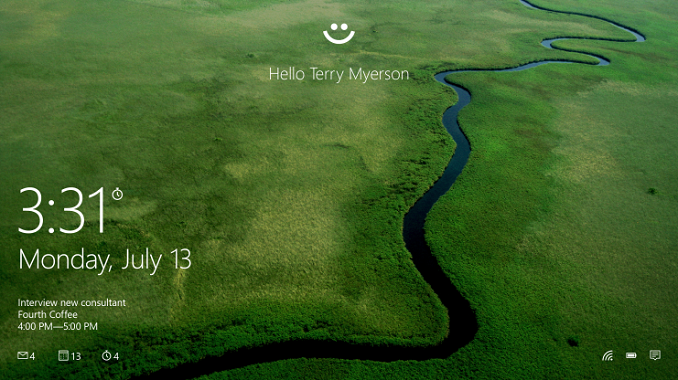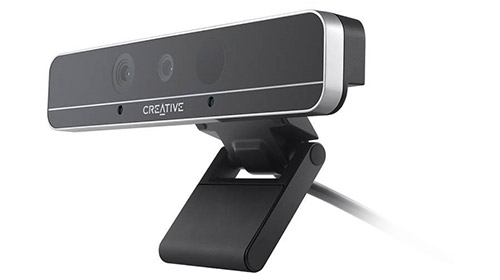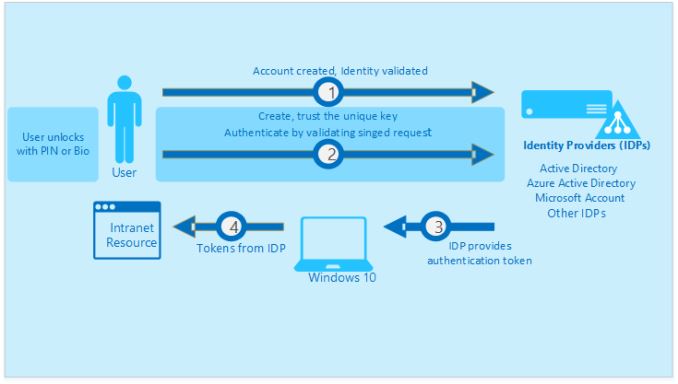The Windows 10 Review: The Old & New Face of Windows
by Brett Howse on August 25, 2015 8:00 AM EST- Posted in
- Operating Systems
- Microsoft
- Windows 10
Windows Hello and Passport
Welcome to the future. Windows 10 includes a new feature called Hello, which may change the way we log into our computers forever. Maybe that is a bit dramatic, but Windows Hello is a new framework which allows biometric logon to Windows, and it can include facial recognition, fingerprints, or even iris scanning technologies to authenticate you.
Now let’s take a step back. Windows has of course supported this in the past, and laptops have come with fingerprint readers for years. Much of that was through third party support, but you could easily set up Windows 8 to log in with a fingerprint. So this is not all new, but the new framework may be one of the biggest changes to come yet.
Windows Hello is meant to be a replacement for the traditional password logon. No one really likes passwords, but it is what we have, and therefore it is what we use. Maybe, just maybe, with Windows Hello we can start to move away from passwords. But, we are a long way from there yet. Let’s dig into Hello.
As I mentioned, laptops have come with fingerprint readers for years, and Windows 8 had native support for this (Windows 7 may have as well but I’ve not used a laptop with a reader on Windows 7) and you could pretty easily set it to log in. Windows Hello takes this to the next level with more options for login. At launch, there is support for fingerprints, iris scanning, or facial recognition.
In order to allow facial recognition but not easily be fooled by photos or other objects, Windows Hello requires an infrared camera. Right now, the only supported model is the Intel Real Sense 3D camera system, which was something that was shown off quite a bit at CES earlier in 2015. At the time, I wondered what the point of these 3D cameras were other than for some interesting demos, but clearly the companies were aware of this upcoming framework from Microsoft.
Microsoft has had some experience with this in the past. Kinect, which is an add-on for the Xbox, also allows facial recognition in order to log you in to it. I have to admit that my own experience with the Kinect for this function was so frustrating that I almost cheered the day they added the ability to automatically log into the Xbox One without the Kinect. So I was a bit skeptical about Windows Hello. One of the biggest issues I had on the Xbox One is that it would constantly think my eight year old son was me, and though people always say we look alike, I would think that the thirty extra years of age would make it somewhat obvious that we are not the same person.
I’ve been able to test out Windows Hello with the Intel Real Sense 3D camera dev kit, and I have to say the entire experience is almost perfect. It was incredibly easy to set up, and once configured, the entire process takes only around a second from the time it sees me to the time it logs me in. It seems much more accurate than Kinect, and part of that could easily be the distances it is used at versus the Kinect which often has to read my face from eight or ten feet away. But time after time, it quickly recognized me and logged me in, and once you experience it moving back to typing in a password is going to be a challenge.
I also tried to have it log in when my son was sitting in front of the PC, but he was not recognized, which is exactly how you want it to work. That's a pretty small sample size, but it's already better than Kinect was for me. The Australian had the resources to do a small test as well, but they were able to gather up six sets of idential twins. In none of the cases was the other twin able to unlock the device, so clearly there has been a lot of work to ensure that only the correct person unlocks the machine.
There are some extra security features too you can set up for Windows Hello. You can set it to not automatically unlock the screen if it sees you, which could be helpful in a corporate environment where you are near your computer but not at it, and you can also set it to have you turn your head from side to side before it will unlock, which should help with a more accurate unlock.
This is one of those features where once you first see and use it firsthand, it is almost a must have. I’m not sure if this will drive adoption of Windows 10 on its own, but I would certainly see it driving higher adoption for devices which include it versus those that do not. Hopefully we start to see this incorporated into desktop monitors as well.
Passport
Windows Hello is login, so what is Passport then? Passport is the next step. Windows Hello helps you log into your computer, and Passport is a service to help you log into everything else. This is another framework which can be leveraged in order to provide secure login to services without having to give them a password. There have been some pretty big cracks of online password databases in the last while, and any work to move to a new system which doesn’t require you to have a password at every location is something that will hopefully gain traction.
I think the most confusing aspect of Passport is its name. Passport was at one time the name of your Microsoft login, which was eventually named your Windows Live account, and now your Microsoft Account. It is also used in some other products like the Passport Authentication Protocol for WinHTTP. Confusing as it may be named, how it works is actually fairly simple.
Rather than authenticating with a username and password to a service or website, Passport will instead use a public/private key pair. The private key is stored in the machine and can be protected by the Trusted Platform Module (TPM) if it is present. Services or websites will get a copy of the public key. When a request to authenticate is made, the request is signed by the private key, which can then be opened by the public key.
But before all of this happens, Windows will prompt you to ensure you are in control of your device, using a PIN or Windows Hello. That way, if you leave your computer unlocked, people passing by can’t get access to your bank account using Passport.
None of this security technology is new, and that’s a good thing in the security world. Public/Private key pairs are what already powers all HTTPS traffic on the internet now.
The beauty of using a public key instead of a password is in the event the service is compromised. Attackers no longer gain access to a username and password which may or may not be the same one used by that person on many websites and services. Instead they get a public key, which can only be used to verify requests which come from the corresponding private key. Public keys are called that because they can and are made public for that single purpose.
Both of these technologies are a big step forward for the computer industry. We have already seen how much biometrics can help when looking at devices like the iPhone. For any inherent insecurity of using a fingerprint reader, the actual security is much higher than people using a four digit pin, or worse yet, nothing at all. Technologies like Windows Hello and Passport can be the solution to better security and ease of use. Hopefully both will gain traction with the ramp up of Windows 10.














293 Comments
View All Comments
Brett Howse - Wednesday, August 26, 2015 - link
Page 4 on Continuum. Overall it's a slight step back on touch.marvdmartian - Wednesday, August 26, 2015 - link
[from the last page of the article] "But is this going to be the upgrade to move people off of Windows 7? In my opinion, yes it is."Perhaps in your world. Not so much, in mine. Nor, in many people I've talked to, who are equally unimpressed with this latest version of Windows.
In fact, so far, what I've seen (though, I admit, not yet experienced) of W10, I'd label it more of a Windows 8.2.....maybe 8.25. Still blocky looking. Still looks like the icons were drawn by a 3rd grader (no offense to the average 8 year old). Still.....just plain UGLY.
I understand the reasoning for the postage stamp sized blocks, as it makes touch interface much easier. But if they want TRUE switch-ability between touch interface and mouse/keyboard usage, they need to change the look of things, to go with the 2nd choice. Then there's also the return to the 90's screen resolution. Necessary for touch interface, perhaps. But when a person has spent hundreds of dollars on a high resolution monitor, then "upgrades" to Windows 10 (8.25?), they do NOT want to have to dial back their resolution to that which was supported first by what? Windows 98??
And don't even get me started in on the privacy issues. Yes, some people might not have a problem with the information Microsoft is gathering. But I'm betting plenty more will, once they're made aware of it. And for MS to force you to opt OUT of information gathering, makes them somewhat "big brother"-ish, in my book.
Sorry, Brett, but in my book, Microsoft is quickly striking out with this operating system. As far as their support of Windows 7, don't be surprised if they don't extend it, just as they did with Windows XP, if the majority of 7 users don't bother upgrading to 10.
chrome_slinky - Wednesday, August 26, 2015 - link
Unfortunately, for people who think, we must realize that the average user IS stupid, and FREE is making them weak in the knees.I will be on Windows 7 until 2020 at least, and carefully removed the "updates" which install more telemetry from my list of updates.
BTW, you could always use the "illudium235 space modulator" to take care of things, couldn't you? <g>
uhuznaa - Wednesday, August 26, 2015 - link
I'm sick of repeating this over and over but you really shouldn't confuse "is not interested in how computers work" with "stupid". I've seen people who are really bright in their fields totally struggling with their computers because they're just not interested in nor care for how these things work.It's like calling you "stupid" because you are not interested in knitting your own sweaters. I bet there are thousands of things you don't care for and are not interested in which others who are not necessarily smarter than you are really good in.
On the other hand not understanding this may be reason enough to call you stupid.
Michael Bay - Wednesday, August 26, 2015 - link
So, it`s you and your two and a half friends. Such tremendous loss for MS, certainly, somewhere in some basement Nadella is crying crocodile tears.Da W - Wednesday, August 26, 2015 - link
I moved from the FRENCH version of windows 7 to the FRENCH version of windows 8 to the FRENCH update of windows 8.1, somehow it installed the ENGLISH version of windows 10.chrome_slinky - Wednesday, August 26, 2015 - link
Zut alors!Billy_Boy - Wednesday, August 26, 2015 - link
The most thorough, well thought out review of ANY product I have read in a long, long time.Bravo!
milkod2001 - Wednesday, August 26, 2015 - link
I gave it a try and got w10 installed on top of my w7. All took about 30 minutes. All applications/games are working which is great. But that got me thinking what is WINDOWS 10?It feels just like windows 7.1 upgrade. New graphic interface, better boot time and slightly faster copy of files. OK lets not forget dx12 and Cortana. It took MS 6 years since release of w7 to put together this massive update and call it w10. Now i get why MS gave it to us for FREE. It just could not dare to charge us for bunch of mediocre updates.
Happy w10 user here :)
azazel1024 - Wednesday, August 26, 2015 - link
Can I just say, if you are coming from Windows 7, Windows 10 is a fairly nice upgrade. If you are coming from Windows 8.1, especially if you have a touch interface, it is a serious reversion in almost every possible way. Most of the apps seems half finished at best. As eluded to in the story, the mail client is about 10 steps back from the one in 8.1. How basic is it to have the ability to change from conversation view? Photos app doesn't support the ability to view images by folder (which can be nice instead of seeing every single one of your pictures spread out by date). Edge can't download some file types, so you have to open them in IE11. If you want to change audio volume, there is no option to do that in the action center (plenty of room for a button for it). So for a tablet, you have to pull up the task bar to do it, which doesn't make sense. Want to change a wifi network? Oh, there is a button in the action center to do...oh, it only turns Wifi on and off...but, wait, there is an airplane mode button also in there to do that. Oh, you can long press on the wifi button, then go in to settings and then select a different wifi network. Want to change the brightness to anything other than 25/50/75/100%, long press again and go in to settings and then you can adjust it from 0-100% in 1% increments. But...why can't there at least be a 0% brightness on that short cut button? 25% is too bright in a dark room. WHY!Sooooooo much of Windows 10 from what I have seen is "why in the hell would you do it that way?" Sure, some stuff in 8.1 was non-intuitive and took awhile to get used to, but a lot of stuff was a quick gesture and done. Want to change the brightness or audio? Swipe in the charms bar, hit the button and adjust away. Now they are found in different places and one of them takes several extra actions to really be able to adjust where you want it. Many of the apps have lost functionality, even if they look a little nicer or have a few new and nice features. I love that Edge is faster, but it sucks for touch input now and a lot of features have been lost that were highly useful, even with keyboard and mouse input.
Windows 10 at best feels half finished as an operating system. I don't mean "they'll innovate the 'OS as a Service that is Windows 10'". I mean, they needed to have spent at least a few more months baking this thing before sending it out the door and if a lot of this stuff isn't "changed" or give the user the ability to customize (why not add more options that you can add to the action center? What about allowing the user to ELIMINATE options in the action center too, I don't need half the crap that is in there as a short cut) then frankly Win 10 is a big step backward in a lot of ways.
I am willing to give it a try for awhile, but I am itching every single day to reload Windows 8.1 on my Asus T100. I am certainly not going to load Windows 10 on any of my other machines for a very long time to come (either right before the 1 year upgrade period ends, or possibly never).